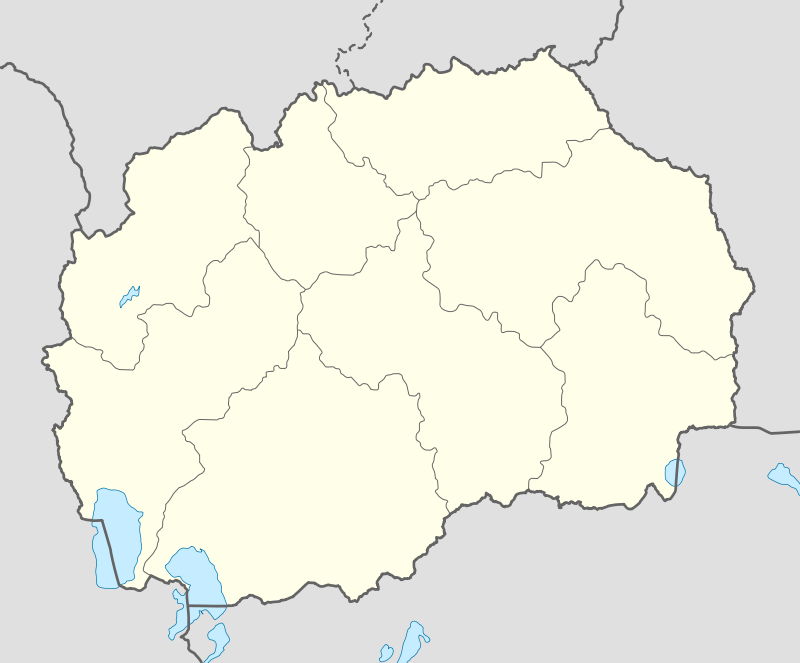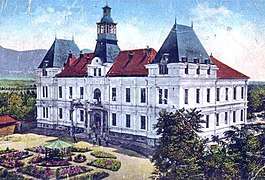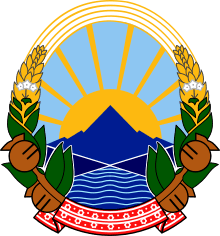Resen, Macedonia
| Resen Ресен | |||
|---|---|---|---|
| Town | |||
|
| |||
| |||
 Resen Location within Macedonia | |||
| Coordinates: 41°05′20″N 21°00′44″E / 41.08889°N 21.01222°ECoordinates: 41°05′20″N 21°00′44″E / 41.08889°N 21.01222°E | |||
| Country |
| ||
| Municipality | Resen Municipality | ||
| Government | |||
| • Mayor | Gjoko Strezovski (VMRO-DPMNE) | ||
| Elevation | 885 m (2,904 ft) | ||
| Population (2002) | |||
| • Total | 8,748 | ||
| Time zone | UTC+1 (CET) | ||
| • Summer (DST) | UTC+2 (CEST) | ||
| Area code(s) | +389 | ||
| Car plates | RE | ||
| Climate | Cfb | ||
Resen (Macedonian: Ресен [ˈrɛːsɛn] (![]()
Name
The name of the city in Macedonian is Resen (Ресен), in Serbian Resan (Ресан), and in Turkish Resne, while in the Aromanian language it is Reșani. In Albanian the town is known as Resnjë; definite form: Resnja.
History
The ancient Illyrian city of Damastion[2] may be near Resen. Resen's history dates back to Roman times when the famous road Via Egnatia was built, passing through the city.
During the Middle Ages, the Prespa area was part of the Bulgarian empire under Samuil. After the Battle of Klyuch, some of Samuil's soldiers, who were each blinded in one eye, settled in a village on the shore of Lake Prespa. The Byzantines called the village Asamati. The Byzantine meaning of this word is "settlement of one-eyed people". From then on, Resen was under Byzantine rule.
Later, Resen became part of the Second Bulgarian Empire, Serbian Empire and Ottoman Empire, and it was the birthplace of Ahmed Niyazi Bey, an Albanian officer from a noble family of the town, who was one of the initiators and leaders of the Young Turk Revolution in the region in 1908.[3] Ahmed Niyazi Bey's most famous monument in Resen is the Saraj, a French-style estate he built.[4] In the late 19th and early 20th century, Resen was part of the Manastir Vilayet of the Ottoman Empire.
From 1929 to 1941, Resen was part of the Vardar Banovina of the Kingdom of Yugoslavia.
 Resen in the early 20th century
Resen in the early 20th century Old picture of the Saraj
Old picture of the Saraj
Demographics
As of the 2002 census, the town of Resen has 8,748 inhabitants and the ethnic composition was the following:[5]
- Macedonians, 6,431 (73.5%)
- Turks, 1,369 (15.7%)
- Albanians, 325 (3.7%)
- others, 623 (7.1%)
The mother tongues of the city's residents include the following:
- Macedonian, 6,574 (75.2%)
- Turkish, 1,355 (15.5%)
- Albanian, 629 (7.2%)
- others, 190 (2.2%)
The religious composition of the city was the following:
- Orthodox Christians, 6,382 (73.0%)
- Muslims, 2,272 (26.0%)
- others, 94 (1.0%)
A sizable amount of the Macedonian population originates from the villages of Podmočani, Bolno, Malovišta and other villages from the Lake Ohrid area who settled in Resen during the middle of the 19th century.[6] The Albanian population settled in Resen during first decades of the 19th century originating from the Yanya vilayet.[6] In contemporary times Muslim Albanians live in small numbers within Resen.[7] In the latter decades of the 20th century, some Albanian speaking Muslim Romani from the villages of Krani and Nakolec have migrated to Resen.[7] Most of the Muslim population living in Resen speaks Turkish and are either descended from Turks settled in strategic areas or the descendants of local Turkified Slavs during Ottoman rule.[7] A small population of Orthodox Aromanians also lives in Resen.[7]
Climate
Resen has a mild continental climate with cold winters and warm summers, which makes it a tourist attraction, especially in summer. The climate and the quality of soil are key factors for Prespa's region to have a long tradition of agriculture. One of most important landmarks of Resen's today are the apple orchards, well known for the quality and specific taste of apples.
Culture

Resen is home to Prespa's Ceramic Colony, established in the 1970s, which attracts renowned artists from all over the world. The organization is included in the UNESCO International Academy of Ceramics. It is housed in the Saraj, which also houses the Dragi Tozija House of Culture, the Keraca Visulčeva Gallery, and a library.
References
- ↑ Municipality of Resen
- ↑ Barrington atlas of the Greek and Roman world: map-by-map directory, Tome 1,by Richard J. A. Talbert,page 758,near Resen?
- ↑ Kedourie, Sylvia (2000). Seventy-five years of the Turkish Republic. Psychology Press. p. 32. ISBN 978-0-7146-5042-5. Retrieved 18 February 2011.
- ↑ Macedonia National Tourism Portal Archived November 15, 2006, at the Wayback Machine.
- ↑ "Macedonian census, language and religion" (PDF). Retrieved 2013-09-03.
- 1 2 Włodzimierz, Pianka (1970). Toponomastikata na Ohridsko-Prespanskiot bazen. Institut za makedonski jazik "Krste Misirkov". p. 125. "Македонски жители се дојдени во градот во средината на XIX в. од селата Подмочани, Болно, Маловишта и др. од Охридско. Албанците се дојдени во првите децении на XIX в. од Јанинскиот вилает."
- 1 2 3 4 Sugarman, Jane (1997). Engendering song: Singing and subjectivity at Prespa Albanian weddings. University of Chicago Press. pp. 9–10. ISBN 9780226779720.
External links
| Wikivoyage has a travel guide for Resen. |
| Wikimedia Commons has media related to Resen. |


